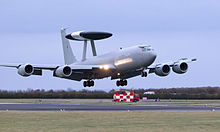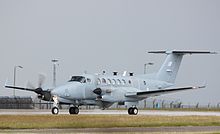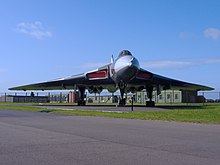RAF Waddington
The station is the RAF's Intelligence Surveillance Target Acquisition and Reconnaissance (ISTAR) hub.
As part of the pre-war expansion programme, the Waddington site was earmarked for development into a fully equipped heavy bomber station.
44 Squadron moved in from RAF Andover, flying the Blenheim, before switching to the Avro Anson and the Hampden in February 1939.
Both squadrons were in action on the same day as Britain's war declaration, attacking German naval targets at Kiel.
[6][18] Waddington squadrons were also involved during the critical stages of the late summer and early autumn of 1940, attacking barges in the channel ports which were being assembled as part of the invasion fleet.
44 Squadron took off from Waddington as part of Operation Margin, a bombing raid on the MAN U-boat engine plant in Augsburg in Germany.
[29] In August 1960, the station developed the 'sudsmobile' technique to lay a 1,000 by 30 yards (914 by 27 metres) carpet of foam in around a half-hour for a wheels-up landing.
An English Electric Canberra from RAF Wyton landed wheels-up on 23 August 1960, with a Handley Page Victor managing the same on 5 December 1960.
RAF Waddington was home to several USAF Coronet deployments throughout the Cold War: During the Falklands War, Operation Black Buck saw three aircraft and crews from Waddington take part in a long-range bombing raid on Port Stanley airfield in the Falkland Islands.
[42] A complicated air-to-air refuelling plan, involving fourteen Handley Page Victor K.2 tankers, was developed,[43] which was only contemplated due to the belief of Sir Mike Beetham, then Chief of the Air Staff, who had developed the RAF's in-flight refuelling capability with Vickers Valiants with 214 Squadron at RAF Marham in 1959.
The squadron was equipped with the Rapier Field standard C short range air defence missile system, and remained at Waddington until its temporary disbandment in 2008.
[49] All of the aircraft-operating squadrons based at RAF Waddington were dispersed to other airfields in July 2014 when the runway was closed for rebuilding.
216 Squadron reformed at Waddington on 1 April 2020 as an experimental unit testing future drone swarm technology.
[52] In September 2020, work to convert an existing aircraft hangar into a joint flight simulator training facility was completed.
39 Squadron disbanded, with a MQ-9A Reaper ground control system returning from Creech Air Force Base in Nevada to Waddington for use by No.
31 Squadron was re-formed at Waddington in October 2023, equipped with the General Atomics MQ-9B, a remotely piloted air system which is known as the Protector RG1 in RAF service.
[59] A new hangar, support facilities and crew accommodation were constructed at Waddington; in 2018 it was said that the cost of this project would be £93 million.
It is a mix of the staff and capabilities of the Tactical Imagery Intelligence Wing (TIW) at RAF Marham, No.
The station badge depicts Lincoln Cathedral rising through the clouds, with the motto 'For Faith and Freedom' emblazoned below.
It took place on the first weekend in July, attracting over 140,000 visitors and representatives of air forces from all round the world.
The main purpose of the show was to raise public awareness and understanding of the Royal Air Force and its role today.
[91] These security risks have generally centred on RAF Waddington being used as a base for the operation of Reaper drones.
[92] In February 2016, it was announced that following an agreement between the Royal Air Force and the Royal Air Force Charitable Trust, the venue of the airshow would switch from RAF Waddington to RAF Scampton, with the hope that the airshow would be resurrected in 2017.










